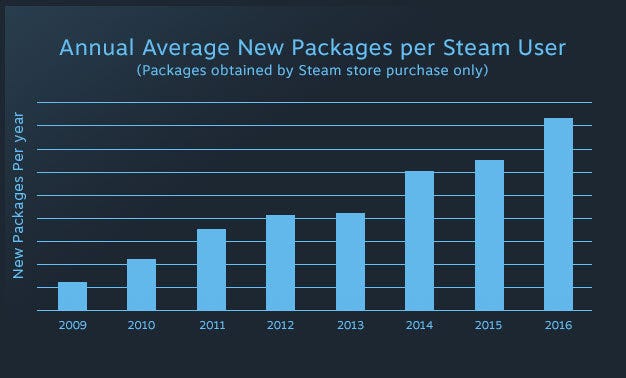Valve Software's Alden Kroll shares fascinating insights into his company's efforts in handling the influx of game releases on Steam.

Alden Kroll is a UI designer at Valve Software. This article originally appeared on the Steam Developer Community forums. Reprinted with permission.
Steam’s primary goal is to connect consumers with content creators. Along the way, there are a number of challenges for different content types, such as connecting with friends, connecting with communities, and connecting customers to the most relevant games to buy and play.
This blog post explores how Discovery Updates 1.0 & 2.0 have affected customers’ abilities to find great games, while also examining the growth of user investments on Steam and the increasing number of successful games on the platform.
Showing the Right Games to the Right Customers
In the past, Valve dictated which games appeared to all customers on Steam. However, we found that trying to make a prediction for all customers was vastly underserving the diversity of customer tastes. This system also limited the opportunities for surprise hits.
Over the past two years, a series of updates to the Steam store, including Discovery 1.0 and 2.0, have brought major changes to the way we highlight games for customers, providing a more personalized experience tailored to individual tastes. As a result, Steam is a better place for both customers and content creators, and the data supports this.
An example of this is the Steam front page, where, the improvements of Discovery 2.0 have resulted in showcasing 46 percent more games to customers via the main product capsule. Refining our discovery algorithms has allowed us to increase visibility for more titles, most notably exposing smaller titles to the right audiences.

Showcasing 46 percent more games on the front page sounds great, but how do we know we are showing the right games to customers? After the launch of Discovery 2.0, customer purchase conversion from the main capsule increased by 27 percent. The new main capsule algorithm has recommendations that leverage community activity (such as what your friends are playing), in addition to previous behavioral inputs (game playtime, wishlisting, etc.). The “Recommended by Friends” capsule now has a conversion rate of 15 percent, the highest of any capsule on the front page. Additionally, we’ve provided customers with much-requested tools to filter out the types of games they’re not interested in. This filtering, combined with improvements to game featuring, has made the store dramatically more relevant for each customer.
Steam’s Recent Growth
Two important metrics in measuring customer satisfaction are how much money and time are spent. Since the introduction of the Discovery Updates, per player purchases have nearly doubled, with each customer purchasing an average of 8.3 new packages (containing one or more games) in 2016.
 Additionally, the time each user has spent playing games on Steam each year has also seen a steady increase, across a wider variety of titles.
Additionally, the time each user has spent playing games on Steam each year has also seen a steady increase, across a wider variety of titles.

Growth in Games and Hits on Steam
Steam needs to be a place that supports surprise hits from new developers, as well as blockbuster titles with huge marketing budgets. From triple-! games with teams of 300 to indie titles made by a single developer, and everything in between, we think it’s important that creators have a direct path for reaching customers.
With that in mind, we wanted to make sure that our changes to Steam weren’t just serving the same small group of highly marketed titles. A healthy ecosystem should be able to support a range of games of various scales and potential audiences.
To examine this, we looked at the metric of how many games earn at least $200k within 90 days of their release. We used this figure as a rough approximation for success.

The data shows that more and more titles are achieving this benchmark each year, while Steam is also seeing more and more runaway successes.
The Future of Steam
The changes that we have made have had positive effects on customer engagement and product visibility on the platform, yet we know there is still work to do. This latest update was just one more step towards the ongoing goal of best connecting content consumers with content creators. We are committed to listening to feedback and iterating in pursuit of this goal.
About the Author(s)
You May Also Like









